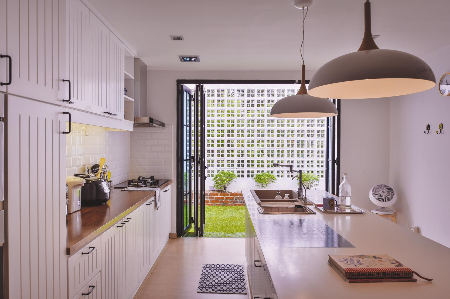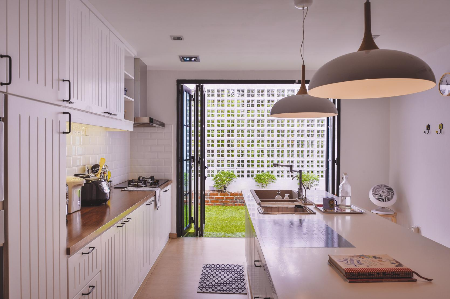Blog categories
Blog archive
RSS Blog posts tagged with 'landed'
Blog Filters
Renovations to Raise the Comfort of Terraced Homes
Friday, November 20, 2020
The terraced home is the traditional starting point for most new families: they provide driveway space for at least one family vehicle, yard space for partaking in cottage industries, and are relatively inexpensive grounded properties—having been constructed en masse from easily repeatable designs. But the root design came about as a solution to an industrial-era problem: the innovation of shared walls provided homeowners in colder climates with the benefit of reduced heating costs, and this feature of terraced homes works to our disadvantage in the tropics. As any who has lived in one would be able to point out: conventional terraced homes seem somewhat unsuitable for our hot and humid weather—an assertion that becomes obvious when air conditioning is needed to render the temperature indoors liveable during the day. In this guide, we take a look at the various tweaks that appear in renovated terraced homes and explore their effects on comfort levels within the interior.
Cooling Materials
 Interior design by: Yong Studio
Interior design by: Yong Studio
Bare concrete is quite adept at retaining heat, more so than brick, and even more than wood—which is why concrete or brick walls are covered with paint or plaster, and even wood is often whitewashed. White surfaces reflect light and consequently retain less heat, but more can be done to cool the interior via the informed selection of materials. In this terraced home renovated by Yong Studio, bare walls are painted white, glossy white tiles are used for the backsplash, white perforated bricks make up the outer perimeter wall, while the floors and countertops are rendered in wood. The wood surfaces do more than brick or concrete to cool interiors without the added advantage of a white coating—the capacity of most varieties of wood to retain and transfer heat is typically a fraction of that for brick or concrete.
 The perforated bricks of the outer perimeter wall reflect light and heat, while allowing the occasional gust of wind to pass through and cool the home from the exterior. Interior design by: Yong Studio
The perforated bricks of the outer perimeter wall reflect light and heat, while allowing the occasional gust of wind to pass through and cool the home from the exterior. Interior design by: Yong Studio
Extended Roofing
 Interior design by: Yong Studio
Interior design by: Yong Studio
Due in part to their lightweight construction, most terraced homes do not typically come with generously cantilevered roofs—leaving modern window panes to catch the brunt of sunlight during the day and radiate that heat into the interior to stifling effect. This characteristic of terraced houses prompts homeowners to add awnings or extend roofs to provide additional shade for the windows below. But while polycarbonate and glass sheets tend to be relatively affordable and uncomplicated to install, these materials are translucent and may do little to beat the heat unless tinted. A full-fledged concrete slab is a more costly alternative, but it provides cooling shade for the windows below—with the added benefit of additional floor space on the upper level.
 Interior design by: Space In Design
Interior design by: Space In Design
Ventilated Roofing
 Interior design by: Surface R
Interior design by: Surface R
The draw of Minangkabau-styled roofs extends beyond the intriguing concave-curved eaves—the traditional roofing design entails air vents in the soffits, which allow hot air to rise up the walls and into the voids beneath the shingles. An observant builder noticed the tendency for hot air to rise and this ancient knowledge enabled people to live comfortably in the tropics, even without the benefit of mechanical air circulation. With this principle in hand, modern roofs can be retrofitted with vents to allow hot air to naturally rise upwards, leaving the floors of the lower levels cool to the touch.
[gallery columns="2" size="medium" ids="58240,58241"]Vaulted Ceilings
 Interior design by: Archicentre
Interior design by: Archicentre
The standard response to an exposed concrete slab overhead is to cover it with a suspended plaster ceiling to provide a uniform surface, but the extra headroom would then be wasted instead of acting as a heat-sink. Just as wine cellars of tradition featured vaulted ceilings to trap and funnel hot air, so do modern homes with ceilings that bear exposed beams. If industrial aesthetics are not quite your bag, the same effect can be achieved with more conforming architectural finishes—as Q1 Interior Concept demonstrates in the home pictured below.
 Interior design by: Q1 Interior Concept
Interior design by: Q1 Interior Concept

Renovations to Raise the Comfort of Terraced Homes
Friday, November 20, 2020
The terraced home is the traditional starting point for most new families: they provide driveway space for at least one family vehicle, yard space for partaking in cottage industries, and are relatively inexpensive grounded properties—having been constructed en masse from easily repeatable designs. But the root design came about as a solution to an industrial-era problem: the innovation of shared walls provided homeowners in colder climates with the benefit of reduced heating costs, and this feature of terraced homes works to our disadvantage in the tropics. As any who has lived in one would be able to point out: conventional terraced homes seem somewhat unsuitable for our hot and humid weather—an assertion that becomes obvious when air conditioning is needed to render the temperature indoors liveable during the day. In this guide, we take a look at the various tweaks that appear in renovated terraced homes and explore their effects on comfort levels within the interior.
Cooling Materials
 Interior design by: Yong Studio
Interior design by: Yong Studio
Bare concrete is quite adept at retaining heat, more so than brick, and even more than wood—which is why concrete or brick walls are covered with paint or plaster, and even wood is often whitewashed. White surfaces reflect light and consequently retain less heat, but more can be done to cool the interior via the informed selection of materials. In this terraced home renovated by Yong Studio, bare walls are painted white, glossy white tiles are used for the backsplash, white perforated bricks make up the outer perimeter wall, while the floors and countertops are rendered in wood. The wood surfaces do more than brick or concrete to cool interiors without the added advantage of a white coating—the capacity of most varieties of wood to retain and transfer heat is typically a fraction of that for brick or concrete.
 The perforated bricks of the outer perimeter wall reflect light and heat, while allowing the occasional gust of wind to pass through and cool the home from the exterior. Interior design by: Yong Studio
The perforated bricks of the outer perimeter wall reflect light and heat, while allowing the occasional gust of wind to pass through and cool the home from the exterior. Interior design by: Yong Studio
Extended Roofing
 Interior design by: Yong Studio
Interior design by: Yong Studio
Due in part to their lightweight construction, most terraced homes do not typically come with generously cantilevered roofs—leaving modern window panes to catch the brunt of sunlight during the day and radiate that heat into the interior to stifling effect. This characteristic of terraced houses prompts homeowners to add awnings or extend roofs to provide additional shade for the windows below. But while polycarbonate and glass sheets tend to be relatively affordable and uncomplicated to install, these materials are translucent and may do little to beat the heat unless tinted. A full-fledged concrete slab is a more costly alternative, but it provides cooling shade for the windows below—with the added benefit of additional floor space on the upper level.
 Interior design by: Space In Design
Interior design by: Space In Design
Ventilated Roofing
 Interior design by: Surface R
Interior design by: Surface R
The draw of Minangkabau-styled roofs extends beyond the intriguing concave-curved eaves—the traditional roofing design entails air vents in the soffits, which allow hot air to rise up the walls and into the voids beneath the shingles. An observant builder noticed the tendency for hot air to rise and this ancient knowledge enabled people to live comfortably in the tropics, even without the benefit of mechanical air circulation. With this principle in hand, modern roofs can be retrofitted with vents to allow hot air to naturally rise upwards, leaving the floors of the lower levels cool to the touch.
[gallery columns="2" size="medium" ids="58240,58241"]Vaulted Ceilings
 Interior design by: Archicentre
Interior design by: Archicentre
The standard response to an exposed concrete slab overhead is to cover it with a suspended plaster ceiling to provide a uniform surface, but the extra headroom would then be wasted instead of acting as a heat-sink. Just as wine cellars of tradition featured vaulted ceilings to trap and funnel hot air, so do modern homes with ceilings that bear exposed beams. If industrial aesthetics are not quite your bag, the same effect can be achieved with more conforming architectural finishes—as Q1 Interior Concept demonstrates in the home pictured below.
 Interior design by: Q1 Interior Concept
Interior design by: Q1 Interior Concept





